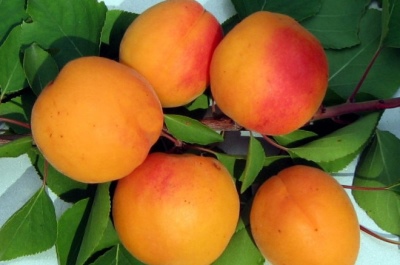
- Authors: Belarusian breeders
- Escapes: medium, greenish brown
- Fruit weight, g: 45-55
- Fruit shape: rounded
- Skin : slightly pubescent
- Fruit color: main orange, integumentary in the form of red spots and dots
- Pulp color : light orange
- Pulp (consistency): tender, juicy
- Fruit taste: sweet and sour
- Separability of the bone from the pulp: medium
Apricots have long been known for their excellent taste and health benefits. The potassium content in fruits is very high, which is important for the prevention of diseases of the cardiovascular system. Fruits grown on your own plot will be especially useful. Apricot Znakhodka is an excellent option for planting in dachas and vegetable gardens.
Origin story
Bred in Belarus at the Institute of Fruit Growing. In 1995, the variety gradually began to be planted in various Belarusian regions, from the north to the south of the country. The authors of the variety are A.V. But-Gusaim, R.E. Loiko.
The variety was obtained from free pollination of a seedling of a Western European variety of the second generation. In 1977 it entered into fruiting, in 1978 it was included in the list of elite varieties. During cultivation, it was always under the strict supervision of specialists, in order to exclude instability to diseases and pests, it underwent thorough checks.
Description of the variety
The tree is large, tall, fast-growing, large, with a crown of medium density. The maximum plant length is 3 to 5 meters. Leaves are medium in size, rounded, shiny. The top is gradually sharpened. The flowers are pinkish. Blooms in early May. Possesses high frost resistance, is grown in different regions of the Republic of Belarus.
Fruit characteristics
The fruits are round, medium-sized, weighing about 45-55 g, the maximum weight reaching 60 grams. The color of the apricot is yellow, the integumentary color is red in the form of small spots. The skin is slightly pubescent. The stone is small, easily separated from the pulp. The pulp is light orange in color, tender and juicy in texture.
Taste qualities
Gardeners who have tasted Znakhodka apricot note the juiciness of the fruit, a pleasant sweet and sour taste. The average tasting score of freshly picked fruits is 4.5 points. The fruit contains sucrose, organic acids, pectin, carotene, vitamin C, potassium.
Ripening and fruiting
The variety belongs to the middle ripening period, ripens in late July - early August. Begins to bear fruit about 3-4 years after planting in open ground.

Yield
In 1983-1996. observations were made, from which it became clear that 1 tree spent 11 harvesting cycles. On average, 17 kg of fruits were collected from it. This figure proves that the variety is fruitful and can be used for planting an entire garden.
Growing regions
The homeland of the variety is arid mountain zones. Today apricot grows well in different regions of Belarus. These are Minsk, Brest and Gomel regions.
Self-fertility and the need for pollinators
The Znakhodka variety is self-fertile, that is, pollinated with its own pollen. No pollinating neighbors are required for successful flowering. Ideal for those who do not want to grow an entire garden.
Growing and care
The ideal time to plant this variety is April.Before planting a seedling, you need to dip the root system of the plant in a mash made from clay, water, and Bordeaux liquid. This will reduce the risk of various diseases in the plant. There are no special rules for planting the Znakhodka variety. Like any apricot, it requires a lot of light, warmth and little wind; additional feeding is needed.
In August, after fruiting, it is necessary to water the tree daily with a solution of wood ash, so that shoots form faster. Such a procedure will allow the plant to winter better, feel comfortable with temperature changes.



Disease and pest resistance
The fruits are resistant to various diseases and pathogens of the fungus, has a high resistance to moniliosis and moderate to clasterosporiosis.

Winter hardiness and the need for shelter
The variety is considered frost-resistant. According to breeders, it can withstand temperatures up to -50 degrees. In fact, everything is a little different. A lot of plants die due to frost and sudden temperature changes in the first years of life. To avoid this, you need a reliable winter shelter. It can be both a specialized covering material and improvised means.
Requirement for location, soil
The most elevated place is required for Znakhodka apricot. There should be a lot of sun and heat on the site, so you should choose the sunny side. It is ideal to choose a place where the sun's rays will fall throughout the day. Also, winds should not be present, as this interferes with the development of the seedling. There are no special requirements for the soil, the only thing is that it must be loosened.
Review overview
Apricot Znakhodka is a popular variety that buyers are actively buying. The reviews are generally positive. Buyers note good winter hardiness, self-fertility, high yield, unpretentious care. People love the variety for its good, delicate taste, the ability to make preparations for the winter.































































